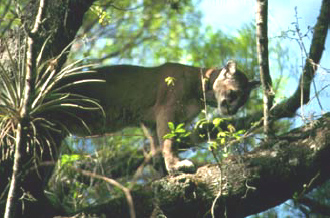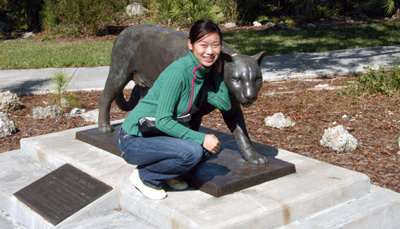
NPS monitors region’s panther population
OCHOPEE, Fla.— The Big Cypress National Preserve was founded in 1972 to provide a habitat for a wide variety of plant and animal life.
In comparison to other parks in South Florida, The Big Cypress is unique for that variety.
In addition, this preserve supports the life of both tropical and temperate species.
The Big Cypress National Preserve is home to some of Florida’s rarest animals. Bob DeGross, the park’s official spokesman, refers to the land as a “temperate and tropical area, and a hotbed of biological diversity.”
Out of all the interesting species and exciting activities the Big Cypress offers, perhaps the biggest attraction is the Florida Panther. It is one of the most endangered species in the world.
 |
A Florida panther in Collier County in southwest Florida (Photo by Larry Richardson and courtesy of the U.S. Fish and Wildlife Service). |
Currently there is an estimated 75 to 100 panthers left in all the Florida preserves and parks. Because of hunting, automobile accidents and pollution in the everglades, the panthers have struggled to remain a prominent animal in the area.
During the past 15 years, efforts have been made to rebuild the panther population and reduce the number of panthers that are killed by human intervention.
In 2003, the National Park Service began a crucial experiment to monitor the daily actions and behaviors of panthers from their time of birth.
By tranquilizing the mother panther, her offspring can be tracked with a collar on their neck. After a couple years of observation it was discovered that most of the panther deaths were caused by habitat destruction and pollution.
Although some panthers were killed by automobile accidents, most were harmed by human actions. It was found that due to the many industries built near and within the Everglades, a sufficient amount of mercury leaks into the Everglade waters each year. The mercury immediately reacts within the panther and possibly gives them feline leukemia.
Of the very few Panthers left in South Florida, more than two dozen of them reside on the 729,000 acres of land in the preserve. That may sound like a lot of space for a few panthers, but their habitat must be large to support their hunting techniques.
At the preserve, visitors can choose from an array of activities. From hiking in the temperate forests, to canoeing down a lake, the preserve makes it possible for a lucky Florida resident or visitor to spot a prowling panther. However these stealthy panthers are known for being nocturnal and usually roam the land at night.
At the end of 2005, park managers and workers became aware of the fact that one of the female panthers was pregnant. Luckily, she already had a telemetry receiver implanted into her skin so it was easy to track the cat’s whereabouts.
 |
A tourist poses for a photo at the Florida panther statue located in Everglades National Park (Staff photo). |
When some of the trained park officials knew she had left her den, they quickly attached identical devices to all of her babies. This way the Big Cypress biologists have a better chance at understanding what happens that makes the panther grow more and more endangered. The trackers also help locate all of the panthers to make sure they are far enough away from any busy roads or highways.
At the preserve, most of the panthers stay near the hardwood swamps, pinelands and wet grasslands. It has been found that panthers that live in the Big Cypress are healthier and have far better chances of living longer.
For organizational purposes, the Florida panthers that are injected with a locator are numbered to be easily identified when necessary.
For example, a Panther could be referred to as FP#79, which stands for Florida panther number 79. It is the hope of Bob DeGross and other park officials that they will continue rescuing and monitoring as many panthers as possible.
According to the Florida Fish and Wildlife Conservation Commission, the panthers draw a lot of attention to South Florida’s parks and it is crucial to keep their numbers growing. Darrel Land, an FWC representative claims that if researchers keep conducting experiments at the rate they are now, there is much hope for a stable panther population in the future.
The South Florida park managers and scientific researchers will continue to work together and provide the panther with a proper habitat to eat sleep and procreate in.

Comments are Closed